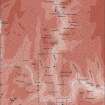Tanlawhill Rig
Burnt Mound (Prehistoric)
Site Name Tanlawhill Rig
Classification Burnt Mound (Prehistoric)
Canmore ID 97918
Site Number NY29SW 76
NGR NY 2359 9164
Datum OSGB36 - NGR
Permalink http://canmore.org.uk/site/97918
- Council Dumfries And Galloway
- Parish Eskdalemuir
- Former Region Dumfries And Galloway
- Former District Annandale And Eskdale
- Former County Dumfries-shire
NY29SW 76 2359 9164
The remains of a burnt mound are visible in the eroding bank of a stream on the SE flank of Tanlawhill Rig. There is no surface profile to the 'mound' but a layer of burnt stone and pieces of charcoal within a matrix of very black greasy soil is visible below the topsoil up to a depth of 0.3m below the turf. The burnt mound layer measures at least 2m in length and 0.4m in thickness and the W end of the deposit appears to cut into the natural clay.
Visited by RCAHMS (JRS), 4 March 1994.
Listed as 'burnt mound'. One of 'at least two sites [the other being Cockgair Hill, NY28SE 55] where burnt stones appear to have been deposited in features cut into the ground'. Both these monuments have been exposed in the banks of burns.
RCAHMS 1997.
Field Visit (4 March 1994)
The remains of a burnt mound are visible in the eroding bank of a stream on the SE flank of Tanlawhill Rig. There is no surface profile to the 'mound' but a layer of burnt stone and pieces of charcoal within a matrix of very black greasy soil is visible below the topsoil up to a depth of 0.3m below the turf. The burnt mound layer measures at least 2m in length and 0.4m in thickness and the W end of the deposit appears to cut into the natural clay.
Visited by RCAHMS (JRS), 4 March 1994.








